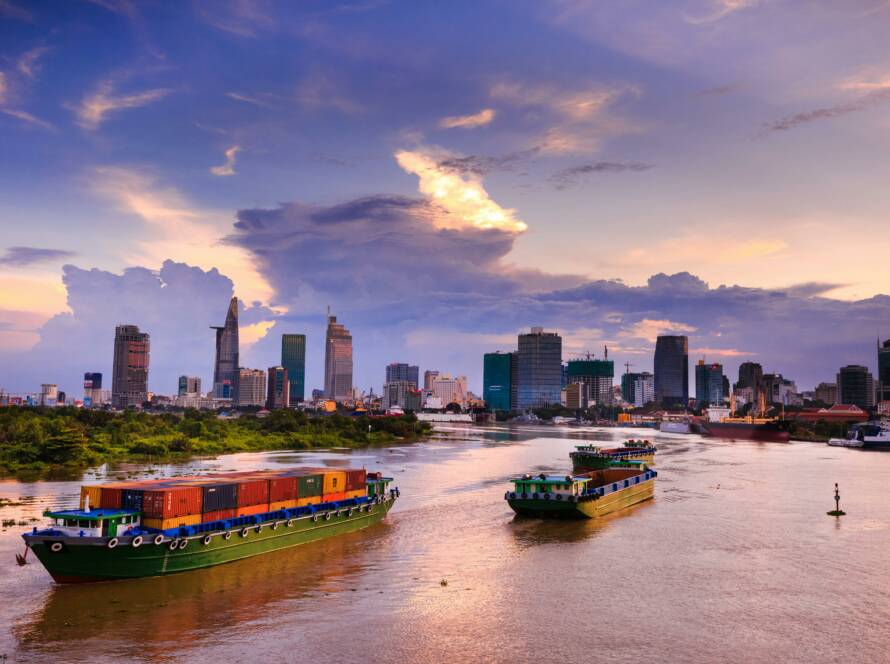In the world of the logistics industry, the transportation of freight is a very difficult task that involves dealing with different types of cargo, each one having its very own threats and unique challenges. Of these, the problem of overweight (OOG) and overweight cargo is the most challenging task.
This blog by Sharp Blue aims to provide a detailed, practical and informative guide to understanding OOG and Overweight cargo, their challenges and best practices for managing OOG and overweight cargo in the logistics industry.
Exploring OOG and Overweight Cargo
What exactly is Out of Gauge (OOG) cargo?
Out of Gauge (OOG) Cargo, sometimes called “over-dimensional cargo,” is basically cargo that’s too large to fit into standard shipping containers, which are usually 20 or 40 feet long and 8 feet wide. These types of cargo cannot fit within the standard containers because of their enormous size and irregular shape, making them “out of gauge”.
Some common types of OOG cargo are large machines, building supplies, Transportation (helicopters, trucks), power and energy equipment (turbine blades, transformers and large generators) etc.
Characteristics of OOG Cargo
- Non-standard dimensions: OOG cargo usually has dimensions that exceed the typical standard container (either 20ft or 40ft), often exceeding length, height and width parameters.
- Complex configurations: OOG cargo generally has unusual and irregular shapes that makes it very difficult to load unload and secure properly. This complex configuration make standard handling procedures impractical.
- Specialized handling requirements: OOG cargo requires special handling. Because of its enormous size and shape, OOG cargo often needs special tools, specialized equipment and trained personnel for loading and unloading.
What exactly is Overweight cargo?
As the name suggests Overweight cargo simply refers to any type of cargo that’s too heavy to ship normally in a standard way. These weight limits differ depending on the mode of transport—whether it’s sea, air, or land—and the specific rules of different countries.
Some common examples of overweight cargo include bulky industrial gear like massive factory machines, forklifts and cranes, heavy construction tools like bulldozers and lift trucks, and big energy equipment such as generators.
Characteristics of Overweight Cargo
- Overweight Cargo exceeds the standard and prescribed weight limit of Transport vehicles.
- Heavy vehicles and specially designed equipment are needed to handle the overweight.
- Overweight cargo may need special documents and must follow the particular laws and rules as directed.
Challenges in Transporting OOG and Overweight Cargo
Transporting OOG and overweight cargo is a very difficult task for freight forwarders as it comes with a unique set of challenges that must be overcome to ensure safe and efficient delivery. Some key challenges are:
1. Transportation Challenges
- Specialized Equipment: Transporting OOG and overweight cargo requires specialized equipment and vehicles such as cranes, flat racks, open-top containers, and heavy-lift trucks.
- Route Planning: Selecting the right route is very important, as certain roads, bridges, and tunnels may have restrictions on dimensions and weight.
- Permits and Regulations: Rules and regulations vary according to region and country. So while transporting one may require multiple documentation and permits.
2. Loading and Unloading Challenges
- Safety Concerns: Handling OOG and overweight cargo is challenging and risky. Proper gear along with specialized tools and equipment are necessary to ensure the safety of personnel as well as the safety of goods during the loading and unloading process.
- Precision Handling: OOG and overweight cargo often need precise handling to prevent damage to the cargo and surrounding infrastructure.
3. Storage Challenges
- Space Requirements: Standard warehouses are designed typically for regular-size cargo but storing OOG and overweight cargo requires more space than regular standard cargo leading to inefficient use of warehouses.
- Handling Equipment: To move OOG and Overweight cargo inside the warehouse or storage area also requires special equipment such as cranes, heavy-duty forklifts, and spreader bars.
4. Regulatory Compliance Challenges
- Permits and Documentation: Each region and country has its own set of rules and regulations for OOG and Overweight cargo. While transporting, multiple permits and documentation may be required, and the cargo may also need to undergo inspections multiple times to ensure compliance with safety standards.
Solutions for Managing OOG and Overweight Cargo
1. Pre-Planning and Coordination
Through detailed pre-planning and coordination, the OOG and overweight cargo transportation can be managed effectively. Freight forwarding companies should ask for a detailed assessment of the cargo’s dimensions and weight beforehand. Next, a route survey should be conducted in order to identify potential obstacles and restrictions during the delivery process. Finally, all the required permits and legal documentation should be taken in advance to avoid delays. Coordination with all the stakeholders, shippers, carriers and regulatory bodies is necessary to avoid mistakes and mitigate risk during the transportation stage.
2. Use of Specialized Equipment
For safe and effective handling of OOG and overweight cargo use of specialized equipment must be used. Flat racks and Open-Top containers can be used for OOG and overweight cargo that cannot fit in standard containers. The use of specialized vehicles like heavy lift trucks, cranes, forklifts etc will be very effective during the loading and unloading process. This will reduce the risk of cargo getting damaged as well as save time.
3. Use Skilled Personnel
To navigate any issue that may arise during shipment of OOG and Overweight cargo it’s important to have skilled and experienced personnel. Experienced and Skilled drivers trained in handling oversized and overweight cargo will make the delivery of shipments safe and fast. For seamless and hassle-free transportation, the use of a professional Rigging expert skilled in securing and handling oversized and overweight cargo would be invaluable.
4. Technology and Software
The Use of the latest technology and Software can enhance and optimize the shipping of OOG and Overweight cargo. The use of proper Transport Management Software (TMS) helps businesses optimize routes, maximize container utilization, and gain visibility into orders and shipments. Using technology like GPS tracking and route optimization software improves navigation and monitoring throughout the transport process.
5. Insurance and Risk Management
To protect against potential loss and ensure smooth operation while transporting OOG and Overweight cargo, robust insurance and risk management practices are essential. Prioritizing insurance and risk management not only provides financial protection but also enhances the overall reliability and efficiency of the cargo transport process, ensuring that potential challenges are effectively managed and mitigated.
Regulatory and Compliance Considerations
International Regulations
When transporting OOG and overweight cargo, it is important to comply with international regulations. This includes:
- International Maritime Organization (IMO): This agency plays an important role in improving the safety and security of international shipping. It also provides guidelines for the transportation of oversized and overweight cargo by sea.
- International Air Transport Association (IATA): This organization helps airlines to operate safely, securely and efficiently under given rules and regulations. It also sets standards for overweight and oversized aircraft carriers.
National and Local Regulations
Other than international regulations, there are national and local regulations that must be followed properly. These include:
- Road Transport Regulations: Each country has its own set of rule regulations regarding the transportation of oversized and overweight cargo on roads.
- Port and Terminal Regulations: Ports and terminals may have specific rules and equipment requirements for handling such cargo.
Conclusion
Moving OOG and overweight cargo is a tricky business that needs planning, coordination and execution. By understanding OOG and overweight cargo, following regulations, and using special equipment and best practices logistics professionals can manage these tough shipments. OOG and overweight cargo transport is all about planning, collaboration and safety and regulations. As the industry evolves, staying up to date with the latest technology and regulations will be key to managing these types of cargo. For those involved in logistics, mastering the transport of OOG and overweight cargo not only enhances operational capabilities but also opens up new opportunities in an increasingly globalized market.



